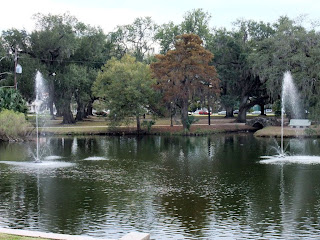

City Park is a 1300 acres of year-run family fun located in the heart of New Orleans. It offers wide menu of attractions, activities, natural masterpiece to sports facilities and attracts approximately 14 million visitors each year. City Park was established in year 1853 and was considered as one of the oldest parks in the country. The area is 50% larger than the Central Park in New York City and is the 7th most-visited urban public park in USA.



The park holds the world's largest collection of mature live oak trees. Some are older than 600 years in age. Many come here just to enjoy the park's magnificent oak trees.


Besides centuries old live oak trees located near the city park avenue in the oldest section of the Park, there are dozens of attractions that make City Park a popular destination in New Orleans.



In 2005 Hurricane Katrina did an extensive damage to the park with winds toppling thousand of trees and damage many more. The entire Park was flooded with 1-10 feet of water remained for 2-4 weeks and followed by the subsequent failure of multiple flood-walls, all buildings, amusement rides, maintenance equipment, electrical system and vehicles were damaged in addition to the death of trees and plants and destroy of landscapes.




Post-Katrina restoration and improvements in the park are the most expensive. As of 2011, The Park is administrated and being re-developed according to its 2005 master plan. Old attractions were repaired and recovered and new ones like the 3 dedicated bike ways were added. Most of the facilities including Stadium, Storyland and Botanical gardens have been reopened.



City Park also suffered neglect in mid 20th century as like cases of many urban parks. The cuts in budget ended up with insufficient maintenance. Towards end of 1979, "Friends of City Park" were then formed to rally support and raise resources for the park.



City Park was originally established on land fronting Metairie Road, the area where City Park Avenue is, along the remains of Bayou Metairei, a former distributary Mississippi River in the mid 19th century.



In the first two decades of 20th century, numerous improvements were undertaken and notable park landmarks were constructed followed by substantial improvements to park's acquired land including installation of many sculptures, buildings, bridges, road and much of the electrical and plumbing infrastructure.





City Park features four 18 holes golf courses , a 100 ft tee double decked driving range, over 5 tennis courts, more than a dozen softball and soccer fields plus other athletic fields and facilities. All golf courses were damaged by Hurricane Katrina induced flood including the one that hold the City's PGA Tournament.



City Park is comparatively unusual as it is a largely self-supporting public park with most of its annual budget derived from self-generated revenue through users fees and donations. But in the make of the enormous damage inflicted upon the park due to 2005 Hurricane Katrina, Louisiana Dept of Culture, Recreation and Tourism began to partially subsidize the park's operation.



The Peristyle is one of the historic structure constructed between 1907-1917. The renovation of The Peristyle was accomplished through the generosity of Mae and Vincent Saia.


Since 1999, City Park has been the venue for Voodoo Experience which has become the largest of live music events hold in the park.


A formal rose garden was developed and it was the genesis of today's New Orleans Botanical Garden which is a 13 acres lush site containing large collection of temperate, tropical and semi-tropical plants.



Popp's Baustand built between year 1907 to 1917 is one of the historic structure. Pop's fountain was added in 1937.



The stone bridge over a preserved section of an old bayou and the newly expanded New Orleans Museum of Arts.


New Orleans Museum of Arts, original named as Delgado Museum of Art is one of the finest art museum in the south.



Hundreds of bird making the lake by the side of Art Museum a home.


The lotus flower at the front pond of art museum, prestige and elegant.















A polka dog comfortably enjoyed a ride with his master in the museum garden.



The pond was made into a habitat for all these wild geese and ducks.


Wild ducks swimming freely and comfortably at the pond.


The ducklings.


Pond is the home for ducks and geese while home for these pelicans are tree tops.









Storyland is a children's fairy tale themed playground features 26 larger than life storybook exhibits for kids to climb on, to slide down and to pretend within.


Carousel Gardens Amusement Park turns 100 years in 2006.


Goldring-Woldenberg Great Lawn completed in year 2010 was a gift donated by two generous outstanding entrepreneurs, Malcolm Woldenberg (1896-1982) and Stephen Goldring (1908-1997).


City Park offers several multi-purposes arena site like Tad Gormley Stadium, and Pau American Stadium with 5000 to 26,500 seats.



Camellias blossom



Wild flowers.



Masonic Cemetery where most of the tombs were raised above the ground with a small retaining walls that had been filled with soil is along the City Park Avenue on the way to City Park. The cemetery was surrounded by cast iron picket fence and has a few entrance. It has many unusual graves including a lodge tomb that has a set of exterior stairs that give access to the roof of the tomb. The Cemetery was founded in 1865 and even though there are no more sale for this grave yard and no regular maintenance, Mansion Cemetery is still one of the cleanest in the city.


No comments:
Post a Comment